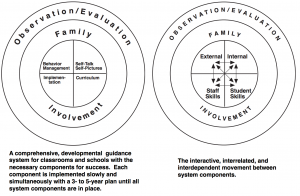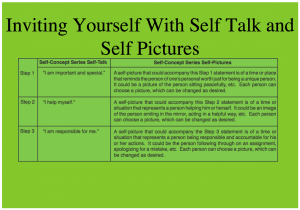Effective Anxiety Interventions Using the Schoolhouse Systems Model
Schools would benefit from a comprehensive plan to address student anxiety and anxiety-inducing situations. School counselors and the school counseling program are key in this process because of their focus on personal, social, emotional, behavioral, academic, and career skills needed for success. Using the anxiety formula and the framework of the Schoolhouse Model (Radd, 2014), this presentation provides strategies and skills in self-talk/self-pictures, relaxation, and mindfulness that participants will take with them to utilize with their students. They will have the opportunity to identify and prioritize 3 interventions and strategies for anxiety to implement at their schools and will have the information needed for strategic planning for comprehensive, developmental, and results-oriented practice.
EFFECTIVE ANXIETY INTERVENTIONS USING THE SCHOOLHOUSE SYSTEMS MODEL
“AOCC Week” Virtual Conference, October 26-30, 2020
Contact information for additional questions:
Dr. Radd, 614-607-1373; email: [email protected];
web site: www.allsucceed.com
Dr. Bhat: [email protected]
Jennifer Ojiambo Isiko: [email protected]
Effective Anxiety Interventions Using the Schoolhouse Systems Model [PDF] 571 KB
“The internal environment people create has a dramatic impact on their ability to become and stay encouraged, optimistic and focused on growth and learning beyond any immediate success or challenge.
– Tommie R. Radd, PhD
Objectives
Participants will:
- Obtain an overview of The Schoolhouse Systems Model and how it aligns with the ASCA National Model (2019) as a comprehensive, developmental, and results-oriented framework for prevention and intervention in schools. See Appendix.
- Learn the Self-Talk/Self-Picture System Component and understand how it may be used to address student anxiety at all levels of PreK-12 schools.
- Learn specific strategies to prevent anxiety and intervene with students experiencing anxiety.
- Prioritize at least one to 3 ways to implement these strategies during the school year and discuss ways to measure effectiveness of strategies.
- Learn about the new Ohio University Dr. Tommie Radd Professorship in School Counselor Education and how they can engage with the Ohio University School Counseling Program and Dr. Bhat, the first Radd Professor. See press release here.
The Schoolhouse Systems Model
A Comprehensive School Counseling Program Model
- The Grow With Guidance System(GWG) includes the Schoolhouse Model. The alignment chart between the GWG System and the ASCA Model Mindset and Behavior Standards explains that both are congruent but the System is more expansive and systemic.
- For the alignment chart, click here.
- The school counseling program is built upon the educational system foundation. Other program components are enrichment programs, small group counseling, individual counseling, staff and family involvement, resource development and professional teams and committees.
- All program components are interconnected with the educational system foundation and apply the skills and experiences from this classroom group guidance system foundation.
Components of the GWG System
- Behavior Management – Extrinsic – what we say and do
- Self-Talk & Self-Pictures – Intrinsic – what we say and believe with what we think and feel
- Curriculum – Student Skills
- Implementation – Staff Skills
- Family Involvement – Family Skills
- Observation/Evaluation
System Components Implemented
- Congruent
- Systemic – identify all components of the System or whole and understand the relationship between components
- Slowly and simultaneously
- 3-5 year process
- The Whole is larger than the sum of the parts
Anxiety in Children
- Anxiety is one of three mental health disorders prevalent in children, along with depression, and ADHD (Centers for Disease Control [CDC], 2020.
- Approximately 4.4 million children age 3-17 years (7.1%) have a diagnosis of anxiety (Ghandour, 2018).
- Further, a large number of students have symptoms of anxiety without a diagnosis.
- Schools would benefit from a comprehensive plan to address student anxiety and anxiety-inducing situations.
- School counselors and the school counseling program are key in this process because of their focus on personal, social, emotional, behavioral, academic, and career skills needed for success.
Anxiety Related to COVID-19 or to Racial Injustice
- The world has changed radically for all of us this year
- Students may be anxious about their own health or the
health of family members - Students (especially African American students) may be anxious about incidents of racial injustice and police
brutality - Parents who are highly anxious may pass on fears and anxieties to their children
- Anxious students may be fearful or worried. They could also be irritable and angry
- Physical symptoms may include fatigue, headaches,
stomachaches, or trouble sleeping - Types of anxiety-related behaviors that students may exhibit include:
-
- Fear about being away from parent/s (separation anxiety)
- Fears about getting ill (related to the pandemic)
- Fears about the police or shootings (related to racial
injustice) - Fears of interacting with teachers and peers at school
(social anxiety) - Fears about the future and about bad things happening
(general anxiety) - Repeated episodes of sudden, unexpected, intense fear
that come with symptoms like heart pounding, having
trouble breathing, or feeling dizzy, shaky, or sweaty (panic
disorder)
Life Lab
- A way of defining the classroom as a simulation in which students, PreK-12 and beyond, learn, experience, and
apply the essential skills needed for life - The comprehensive developmental guidance system creates a life lab in every classroom through which students develop a conscious and intentional frame of reference that can be applied throughout life.
Overview of the System Anxiety Formula
- Comprehensive School Counseling Program System – Program Components Are Interrelated and Interactive
- Guidance System is the Foundation of the School Counseling Program
- Teach the skills needed to handle anxiety
- View personal, social, emotional, and behavioral skills as a priority
- Include the personal, social, emotional, and behavioral skills as part of the core curriculum
- Teach the relationship between academic learning and anxiety
- Provide families with the support and help they need
- View classrooms as life labs for student support and belonging
- Provide students with ongoing assistance for anxiety management as opportunities occur
Practices and Strategies
- Self-Talk – Positive Internal Messages
- Self-Pictures – Positive Internal Pictures
- Relaxation – The State of Being Free From Tension and Anxiety
- Mindfulness – Calm Body – Focused Mind
- Remember:
- Feel ALL as if the Truth!
- Think It! See It! Feel It! Be It!
- Become your Potential!!
General – Universal Specific – Personal – Relevant To An Individual
Anxiety Management Strategy 1: Self-Talk/Self-Picture Plan Activity
- Complete the Self-Talk/Self-Picture Plan Activity
- https://allsucceed.com/wp-content/uploads/2017/10/Page-72-of-INTERMEDIATE.pdf
- The plan includes all components in the Schoolhouse Foundation and is adjusted based on feedback and progress.
Anxiety Management Strategy 2: Pretend you are a Cat…
- Pretend you are a furry, lazy cat. You want to
stretch. Stretch your arms out in front of you.
Raise them up high over your head. Way
back. Feel the pull in your shoulders. Stretch
higher. Now just let your arms drop back to
your side. Okay kitten, stretch again. Repeat.
Source:
https://depts.washington.edu/hcsats/PDF/TF-%20CBT/pages/4%20Emotion%20Regulation%20Skills/Client%20Handouts/Relaxation/Relaxation%20Script%20for%20Younger%20Children.pdf
Anxiety Management Strategy 3: 5 4 3 2 1 Grounding Technique
- LOOK – 5 things you can see
- FEEL – 4 things you can feel
- HEAR – 3 things you can hear
- SMELL – 2 things you can smell
- TASTE – 1 thing you can taste
https://copingskillsforkids.com/blog/2016/4/27/coping-skill-spotlight-5-4-3-2-1-grounding-technique
Your Action Plan
- List 3 ways you can implement the strategies for yourself! Starting with YOU helps you to feel more comfortable with helping others!
- Determine ways you can incorporate a plan for your students and school based on the System and Schoolhouse Information.
- Explain how the practices and strategies address anxiety for you and your students that can be implemented remotely and in different in-person school options.
Appendix
The following documents are provided in the appendix:
- The Grow With Guidance System Crosswalk with The 2019 ASCA National Model Including Mindset and Behavior Standards
- Grow With Guidance System Benchmark and ASCA Comparison
- Grow With Guidance System Charts Including Checklist
- Grow With Guidance System Schoolhouse Model, % of Time, RTI Alignment
- GWG Schoolhouse Model Checklist and Sample Program Report
Choose to Live Life in Joy
Life goes by in the blink of an eye. It’s too short to live upset, angry, resentful, or ungrateful. If you look for the good, you’ll find it. Choose to be happy, to be at peace. Decide that each day is going to be a great day and grab each moment and make the best of it. Refuse to let negative thoughts take root in your mind and refuse to let negative people and situations drag you down. Trust your journey and know that if you make a mistake, it’s okay. See it as a lesson learned and keep moving forward. Spend less time worrying and more time being grateful for those who love you and all of life’s goodness. Choose to live in Joy! – Charity M. Richey-Bentley


